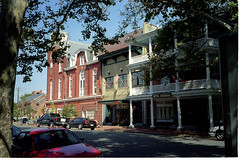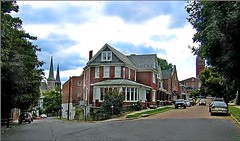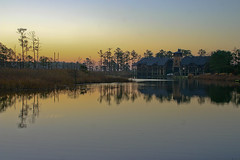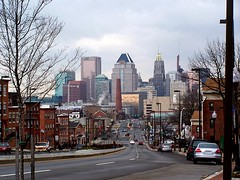Maryland wants to rejuvenate the state's smart growth efforts. Good idea. But.

Posted January 14, 2009 at 12:24AM
Maryland Governor Martin O'Malley announced yesterday that he was introducing six bills in the state legislature to influence the state's land development in a "smart, green, and growing" way. Collectively, the bills would do the following:
- Strengthen local comprehensive plans by overturning a court decision that last year suggested that large development projects in remote locations may go forward even when they violate applicable plans;
- Modernize the state's overall planning goals to give more emphasis to economic development, housing, and public participation;
- Create a self-perpetuating system of state smart growth performance indicators;
- Reauthorize the state's rehab tax credit, with new incentives for green building;
- Strengthen mechanisms for funding transit-oriented development.
- Provide assistance to aquaculture businesses to flourish in Maryland. (Pardon the pun, but this one seems like a red herring to me. It has nothing to do with planning or land use.)
It's a start, and perhaps an important one, insofar as it signals O'Malley's interest in building upon the innovative smart growth program enacted under the leadership of then-governor Parris Glendening in the late 1990s.  Some of the new proposals, such as overturning the Terrapin Run court decision and giving more tools for TOD, are especially laudatory. But it's also a bit modest, given the facts on the ground. Some backstory:
Some of the new proposals, such as overturning the Terrapin Run court decision and giving more tools for TOD, are especially laudatory. But it's also a bit modest, given the facts on the ground. Some backstory:
One of the great pleasures that have come my way from working on these issues has been getting to know and work with governor (as we all still call him) Glendening, who graciously wrote a preface to my book while he was still in office, and with whom I now serve on Smart Growth America's board. Smart growth was his signature legacy (he popularized the phrase "smart growth," for that matter, giving our movement a name), and he continues to devote most of his professional time to the cause.
 The heart of the program, which took effect in 1998, was a requirement that local jurisdictions create designated zones ("priority funding areas") for growth, justified by a showing of development demand. State infrastructure funds in support of new development then would be allowed to flow only to those areas, which were also required to achieve minimum densities. Other parts of the legislation sought to stimulate job creation within the designated areas, preserve farmland, redevelop brownfields, and provide homebuying assistance near places of employment. After the legislation took effect, several outstanding smart growth colleagues took positions with the state to oversee its implementation.
The heart of the program, which took effect in 1998, was a requirement that local jurisdictions create designated zones ("priority funding areas") for growth, justified by a showing of development demand. State infrastructure funds in support of new development then would be allowed to flow only to those areas, which were also required to achieve minimum densities. Other parts of the legislation sought to stimulate job creation within the designated areas, preserve farmland, redevelop brownfields, and provide homebuying assistance near places of employment. After the legislation took effect, several outstanding smart growth colleagues took positions with the state to oversee its implementation.
Unfortunately, changing land use patterns is a notoriously slow process, and the program was allowed to languish during the subsequent gubernatorial administration of Robert Ehrlich, Glendening's successor, who served from 2003 through 2007. This, coupled with the fact that some parts of the legislation were weak to begin with (remember, this was 1998), has meant that the program has produced mixed results.
The successes should not be dismissed lightly. According to a comprehensive and very good report published late last year (Where Do We Grow From Here?),  Baltimore's population has stabilized after years of decline, property values have risen, and there has been some terrific revitalization in the city (see, for instance, The Can Company, which was assisted with state smart growth funds). Outside the city, Baltimore County has emulated the continued farmland preservation success in Montgomery County, northwest of DC. The traditional towns of Cumberland, Easton, and Leonardtown are all being revitalized, consistent with their character.
Baltimore's population has stabilized after years of decline, property values have risen, and there has been some terrific revitalization in the city (see, for instance, The Can Company, which was assisted with state smart growth funds). Outside the city, Baltimore County has emulated the continued farmland preservation success in Montgomery County, northwest of DC. The traditional towns of Cumberland, Easton, and Leonardtown are all being revitalized, consistent with their character.
But the report is also candid about some fairly significant problems:
"While Smart Growth, as defined and implemented in Maryland, has achieved many successes, research and analysis suggest that major challenges remain. The percentage of housing built outside of PFAs
[the designated growth areas] is slightly higher than a decade ago. Transportation investment has not consistently been targeted to PFAs. As of 2007, approximately 430,000 septic systems exist on improved parcels. Land preservation has not accelerated. An increasing share of undeveloped lands is fragmented and as a result, substantial preservation of large tracts of rural land is unlikely in many areas."
Dru Schmidt-Perkins, executive director of 1000 Friends of Maryland (a member of the commission that produced the report, and also a fellow SGA board member) told The Washington Post that "There are visions but no goals or standards" for what new communities should look like under O'Malley's initiatives and, for the most part, that's the way it appears.
 I hope that O'Malley will look at the "smart, green and growing" package as a start, but not as an end to his personal work on these issues. I hope he also takes a hard look at the existing smart growth programs and ramp up their implementation and enforcement, with new legislative muscle if necessary. The fact that so much development is still occurring outside the designated growth areas, many of which were pretty generously designated by their municipalities, is alarming. Maryland's population is expected to increase 27 percent, by some 6.3 million people, by 2030, and the effect on greenhouse gas emissions and the state's justifiably beloved Chesapeake Bay will be immense if the growth is not controlled in a sensible way.
I hope that O'Malley will look at the "smart, green and growing" package as a start, but not as an end to his personal work on these issues. I hope he also takes a hard look at the existing smart growth programs and ramp up their implementation and enforcement, with new legislative muscle if necessary. The fact that so much development is still occurring outside the designated growth areas, many of which were pretty generously designated by their municipalities, is alarming. Maryland's population is expected to increase 27 percent, by some 6.3 million people, by 2030, and the effect on greenhouse gas emissions and the state's justifiably beloved Chesapeake Bay will be immense if the growth is not controlled in a sensible way.
The Where Do We Grow report estimates that the state can reduce newly developed land in that time period from 650,000 acres to 150,000 acres if it's done right. Now that would be smart, green, and growing.

